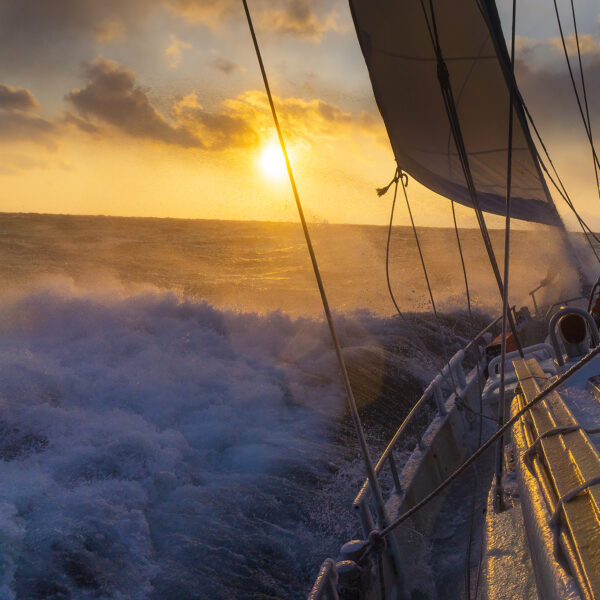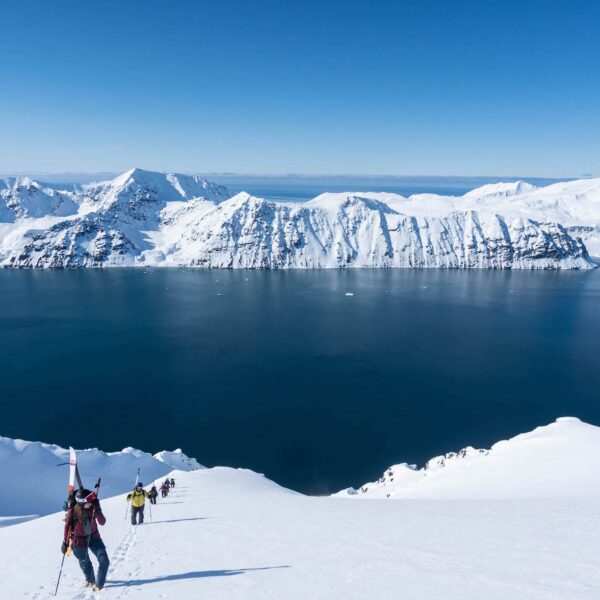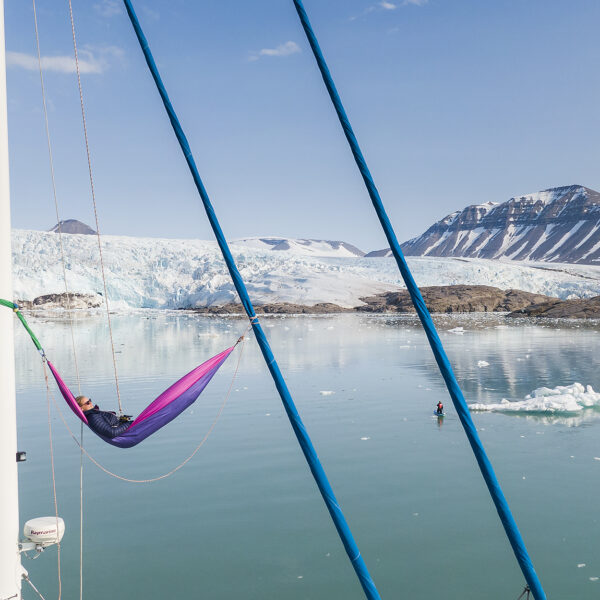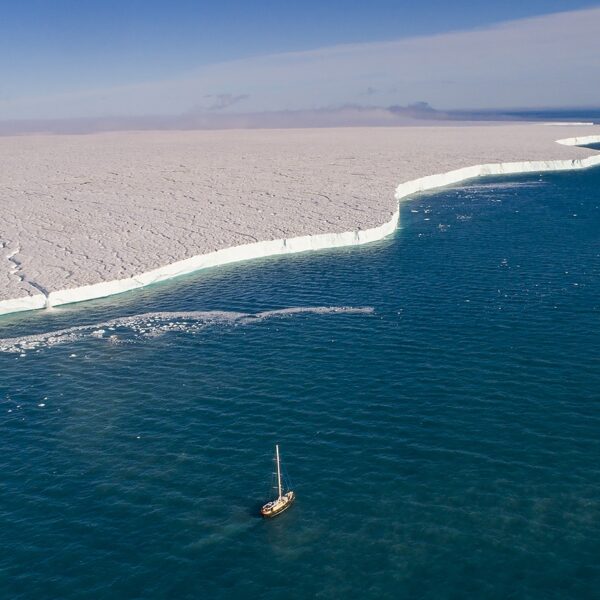
Svalbard
Raw, Arctic Wilderness!
Next to the North Pole
Svalbard, the land north of the north wind, midway between the Norwegian mainland and the North Pole. Svalbard is authentic and rugged, and gives you adventures filled with wilderness, hiking, polar history, wildlife and pioneer & expedition history.
You will find untouched arctic wilderness and unique wildlife in wonderful surroundings. Svalbard offers fjords, mountains and large areas that are still untouched by humans. The tracks we find in nature here are not from humans but from arctic foxes, seals, birds, wild reindeer and polar bears.
The Svalbard adventure
For us, Svalbard represents the definition of Arctic wilderness. We are fascinated by Svalbard and organize more and more trips there. By sailboat, we are in the middle of the wilderness, and are part of the vibrant wildlife both in the sea and in the air.
Do you want to experience the dramatic tranquillity of nature in Svalbard? Get to know the silence and sounds on this magnificent island? Lose Internet access for days? Join a true expedition? Welcome on board!
This magnificent island is one of the most unique and inspiring places we know!
Latest news from Svalbard
Svalbard vibes
FAQ Svalbard
How can I get to Svalbard?
A few, brave souls row to Svalbard, some sail, but most people fly. Norwegian and SAS have flights to Longyearbyen. Learn more about travel tips under Practical Information.
What are SeilNorge’s thoughts on sustainability and the environment in the Arctic?
The Arctic is a vulnerable area under pressure from people and the climate. At SeilNorge, we are committed to preserving the environment to the greatest extent possible. We believe that small boats with few people and minimal pollution and waste are significantly less harmful to the environment, climate, and local wildlife than larger boats and cruise ships. We also try to pick up trash in the places we visit, and leave no traces behind.
In Svalbard, we follow AECO’s guidelines for wildlife encounters, beach clean ups, cultural heritage sites, for visitors and operators in the Arctic. You can read more about AECO’s guidelines here.
Reducing our carbon footprint is important to us. We sail as long as there is wind, and we work purposefully with food and waste management. Even though we have to use the engine for propulsion when there’s no wind at all, our trips are among the most sustainable ways to experience Svalbard.
What is the weather and climate like in Svalbard?
The archipelago has an Arctic climate, but with significantly higher temperatures than other areas at the same latitude, due to frequent low pressure passages and the warm Atlantic Ocean current. The average temperature is -16 degrees Celsius in January and +6 in July. Longyearbyen generally has little rainfall, although there can be rough weather! At the coast, the permafrost layer goes 100 meters into the ground, and in summer only the top meter of soil thaws.
Much of the year is characterized by either polar night or midnight sun, which adds an exciting dimension to nature experiences. Longyearbyen has midnight sun from April 20 to August 23 and polar night from October 26 to February 15.
Polar Night and Midnight Sun in Svalbard
Svalbard experience extreme light contrasts throughout the year. Midnight sun lasts from April 20 to August 23, while polar night lasts from October 26 to February 15. These phenomena create unique atmospheric conditions that affect both the nature and culture of the archipelago. We find it particularly exciting to sail when there’s daylight 24/7! The nights are often calm in terms of weather and wind, and many locals tend to turn their sleeping rhythm around in summer…
What kind of wildlife can you see on a trip around Svalbard?
The polar bear is perhaps the animal most people associate with Svalbard, but there are several other animals that also live up there: walrus, harp seal, ringed seal, harbour seal, beluga whale, bowhead whale, narwhal, Svalbard grouse, arctic fox and Svalbard reindeer. The Svalbard reindeer is genetically different from other subspecies of reindeer. It has shorter legs and can have a fat layer up to 10 cm thick on its body.
The waters around Svalbard are rich in nutrients, and in summer large numbers of seabirds come to the archipelago. There are seven national parks and 23 nature reserves that cover two thirds of the archipelago, and this largely protects the untouched and very fragile nature that characterizes Svalbard.
Svalbard Guidelines
By the Svalbard Tourism Board, in cooperation with the Governor of Svalbard.
- Don’t be an arctic litterbug! Leave no lasting signs of your visit.
- Birds and other animals are not to be disturbed. Remember, you are the guest.
- Help take care of the biodiversity. Do not pick flowers.
- Leave old cultural remains alone. Law protects all traces of humans from before 1946.
- It is prohibited to lure, pursue or otherwise seek out polarbears in such a way as to disturb them or expose either bears or humans to danger.
- Do not leave the settlements without a suitable gun, and experience in using it.
- Be considerate to others.
- Contact the Governor’s office (Sysselmannen) if planning a longer field excursion. A mandatory registration applies for travel to large parts of Svalbard.
- Acquaint yourself with the rules and regulations pertaining to travel and other tourist activities on Svalbard.
- For the sake of both environment and yourself, we recommend organized tour arrangements.
It is impossible being an invisible tourist, – but we do appreciate you’re trying!
How should I deal with polar bears and polar bear safety?
Polar bears are found throughout the archipelago and can be encountered anywhere, all year round. The polar bear is one of the world’s largest predators and is dangerous to humans. When you venture outside inhabited areas, it is legally required to have suitable deterrents. In addition, you must have firearms and be able to use both deterrents and weapons.
On all our trips, we have our own guide who handles polar bear safety in the group. If you are going to be in Longyearbyen for a couple of days before or after the sailing trip, we recommend booking activities with a local operator, or staying with someone who has access to polar bear protection.
Svalbard images












